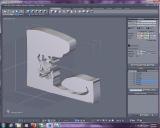How do I combine “forms” into a solid shape?
 lukon100
Posts: 815
lukon100
Posts: 815
I’m trying to make the solid shape shown in my attached screen shot. But the shape I have constructed seems to really be 3 disconnected “Forms” that don’t move or change together.
Form 3 is the edge surface.
Form 7 is the front surface.
Form 8 is the back surface.
I want to use this shape to make a boolean cut into another shape. So I want to make sure that the cutting shape is actually solid. And if it is broken into 3 separate forms, I’m pretty sure it isn’t solid.


Partized Object.jpg
1280 x 1024 - 591K


Comments
Practice with simpler objects first. Get used to merging vertices and triangulating, before doing your boolean cuts.
Thanks for your advice, shawndriscoll.
However, I am confused about why you offer this advice. You do not make clear how your advice relates to my question.
Is that relation one of the following?:
1: You think I'm approaching my project wrong. So I need to back off, learn a lot more about Hexagon in general, before proceeding with my project.
2: Those three forms cannot actually be combined into one solid object. So your advice will somehow help me make the same object in a different way that will make it solid.
3: Something else.
I assumed you were already trying to weld the objects together into one solid object. The rest will make sense when you see odd cookie-cutter shapes being produced. YouTube has plenty of videos showing how to do the steps.
did you try an average weld? its in the vertex tab
Thanks FirstBastion, I finally learned enough to know that the weld function is what I need here. And it worked. I got those forms welded together to make a solid shape.
Unfortunately, the boolean cut I had hoped to make with this solid shape did not work. I tried like 4 or 5 times, but Hexagon crashed every time. I suppose this boolean cut is just to complicated for Hexagon to execute.
I suppose shawndriscoll predicted this would fail from the start.
Anyway, I've basically run out of patience with learning how to make my desired object. I figure that on the day I commit to using my special object, I'll just pay someone else to make it.
Just keep practicing boolean cutting using more simple geometries. That way, you will find a sweet spot that produces best triangulated objects from n-gon objects. N-gons is slang for facets that have more than 4 edges to them.
The object that you are boolean cutting into needs to be hi-res. A dense mesh, rather than a single facet. Something like 100 squares by 100 squares across.
I suspected as much. And so I did make the object to be cut out of lots of squares. I invisioned that the boolean cut would work better if it had plenty of verticies available and close by every face edge of the cutting object.
The trick is how to tessellate the flat surface of your cookie-cutter object. That is one huge n-gon, otherwise.